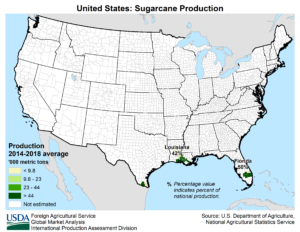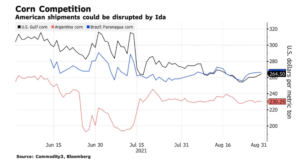Agriculture Secretary Brooke Rollins said on Tuesday that the Trump administration will announce a 'bridge payment' for farmers next week that is designed to provide short-term relief while longer trade…
Hurricane Ida Brings Flooding, and Damage to a Grain Terminal -Export Flows a Concern
DTN Meteorologist John Baranick reported earlier this week that, “Hurricane Ida made landfall near Port Fourchon, Louisiana at 11:55 a.m. on Aug. 29, 2021 as a strong Category 4 hurricane with maximum sustained wind speeds at landfall of 150 mph.”
Heavy rainfall and flooding continue to be concerns for crops and livestock in the Delta and Alabama as the system passes through during the next couple of days.
“Ida’s remnants should pass through the Tennessee Valley on Tuesday, then go through the Mid-Atlantic and Northeast on Wednesday and Thursday, respectively.”
A MODERATE risk is in effect in our Day 1 Excessive Rainfall Outlook. More details: https://t.co/FQU5sb4jjg pic.twitter.com/c4gcVBFBwp
— NWS Weather Prediction Center (@NWSWPC) August 31, 2021
The DTN article noted that, “Prior to the arrival of Ida, the cotton crop was considered in really good shape this year across the Delta and Southeast, with its highest rating in five years.
“However, Ida was threatening flood and wind damage in that area from Sunday afternoon into Tuesday.”
In its Agricultural Weather Highlights from Tuesday, the USDA’s Office of the Chief Economist indicated that, “Post-hurricane rescue efforts continue in the hardest-hit areas of southeastern Louisiana, while recovery is underway across the remainder of the central Gulf Coast region. Some inland areas, mainly across eastern Louisiana and central and southern Mississippi, are contending with major river flooding, although rain has ended. The return of hot, humid weather is complicating hurricane recovery, especially in areas where power has not been restored. Early today, Tropical Depression Ida was moving northeastward into the Tennessee Valley, perpetuating the threat of flash flooding.”
The USDA’s National Agricultural Statistics Service indicated on Monday in its Louisiana Crop Progress and Condition report, that as of Sunday, eight percent of the State’s soybeans had been harvested, while the corn harvest was 79 percent complete. The rice crop was 74 percent harvested.
Also on Monday, USDA meteorologist Brad Rippey offered a preliminary look at Ida’s impacts on agriculture in this one-minute USDA radio segment (MP3). Mr. Rippey noted that Louisiana accounts for almost half of the Nation’s sugarcane production.

Ryan W. Miller reported this week at USA TODAY Online that, “As Hurricane Ida roared ashore in Louisiana on Sunday, the storm’s force was so strong it temporarily reversed the flow of the Mississippi River.”
“A U.S. Geological Survey gauge at Belle Chasse, south of New Orleans, detected the Mississippi’s flow moving backward around midday Sunday because of the volume of water Ida whipped up,” the article said.
And Holly Bailey, Emmanuel Felton and Ashley Cusick reported on the front page of Tuesday’s Washington Post that, “People clung to rooftops awaiting rescue, entire towns were cut off from communication, and more than a million faced the prospect of days — even weeks — without power as Louisianans awoke Monday and began to take stock of the devastation caused by Hurricane Ida.
Parts of the state remained unreachable, making it impossible to fully assess the damage. Two deaths were confirmed, but Gov. John Bel Edwards said he expected the toll to be ‘considerably’ higher.
Meanwhile, Bloomberg writer Michael Hirtzer reported on Monday that, “Hurricane Ida is shaking up grain exports in the U.S.’s busiest agricultural port, a problem that could balloon as the nation approaches its peak harvest season in the coming weeks.
“Farmers in the Midwest will soon begin reaping corn and soybean crops, and a hefty percentage of it flows down the Mississippi River, where it’s then shipped around the world via the the Gulf of Mexico. The U.S. is the world’s biggest corn supplier. If grain elevators and port terminals are still dealing with outages and damage, that could back up exports.”

Mr. Hirtzer pointed out that, “Cargill’s port facility in Reserve, Louisiana, sustained significant damage and there’s no timetable for restarting, according to a company spokesperson.
“ADM said it would reopen four grain elevators in New Orleans that were shut over the weekend depending on the impact of the storm. Bunge shuttered a grain terminal and soybean crush plant in Destrehan, Louisiana.”
@wdsu @WWLTV Cargill grain elevator in Reserve pic.twitter.com/FNTcsG0p57
Similarly, Reuters writers Tom Polansek and Karl Plume reported this week that, “Hurricane Ida damaged a grain export elevator owned by global grain trader Cargill Inc, and rival shipper CHS Inc warned on Monday its grain facility may lack power for weeks after the storm tore though the busiest U.S. grains port.”
The storm has disrupted grain and soybean shipments from the Gulf Coast, which accounts for about 60% of U.S. exports, at a time when global supplies are tight and demand is strong from China.
The Reuters article added that, “‘Best estimates as to when power will be restored at the terminal are in the two to four week range,’ said John Griffith, executive vice president at CHS Global Grain & Processing.
“Cash premiums for grain delivered by barge to Gulf terminals for export fell sharply on Monday as traders feared a prolonged recovery from the storm.”
In addition, Kevin Varley reported at Bloomberg on Tuesday that, “A grain elevator damaged by Hurricane Ida in Reserve, Louisiana is responsible for nearly 9% of America’s bulk seaborne exports of corn, soybeans and wheat so far in 2021, according to Bloomberg’s analysis of U.S. Department of Agriculture data.”
Later on Tuesday, Reuters writer Tom Polansek reported that, “U.S. grain and soybean futures touched their lowest prices in weeks on Tuesday as power outages and damage to export facilities from Hurricane Ida stoked concerns about the potential for extended disruptions to shipments, analysts said.”
And Bloomberg writer Sybilla Gross reported on Tuesday that, “Hurricane Ida, which ripped through Louisiana over the weekend, has left behind broken grain elevators, widespread power outages and shuttered export terminals in New Orleans. With shipping largely out of action in a region that accounts for about two-thirds of U.S. grain and soy exports, there’s concern supply could get backed up as harvest season looms.”





